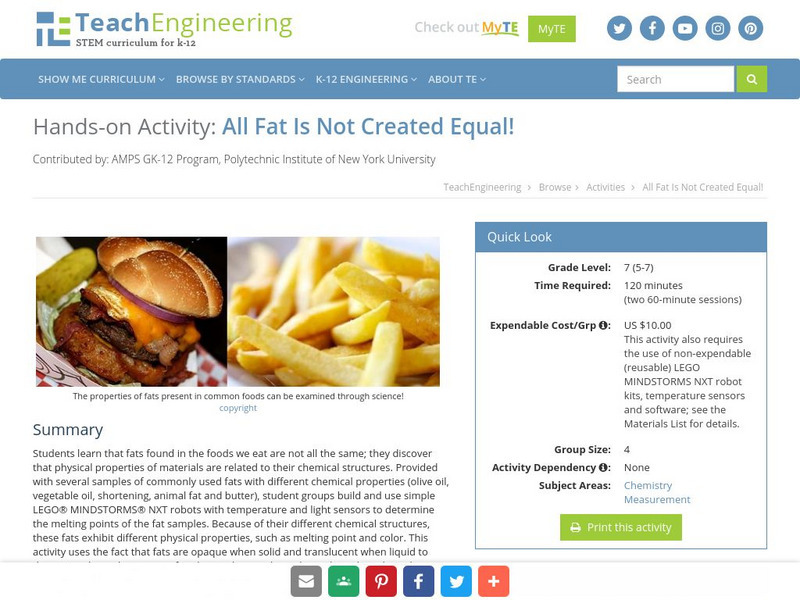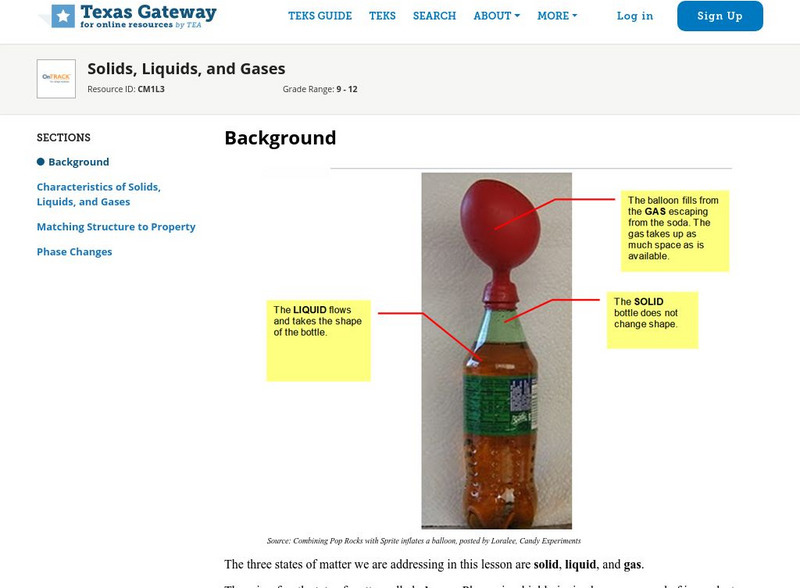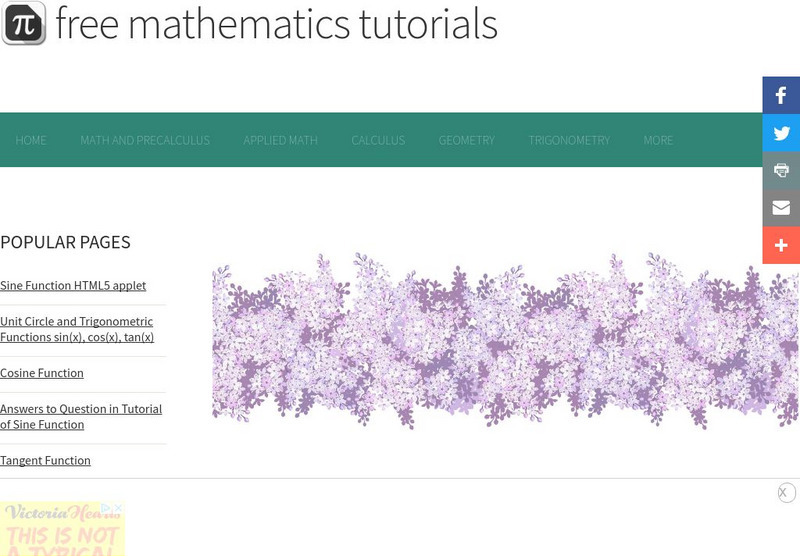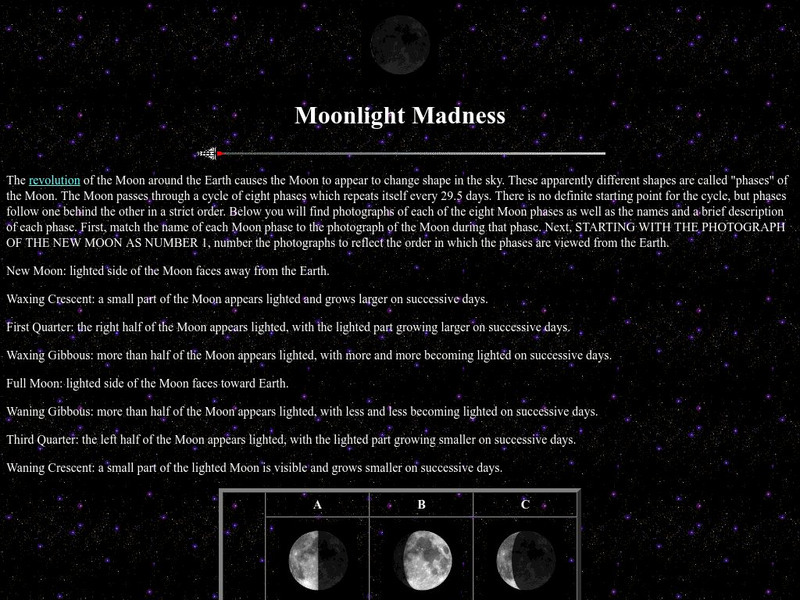Hi, what do you want to do?
TeachEngineering
Teach Engineering: How Cold Can You Go?
Students explore materials engineering by modifying the material properties of water. Specifically, they use salt to lower the freezing point of water and test it by making ice cream. Using either a simple thermometer or a mechatronic...
Utah State Office of Education
Utah Science: What's Up There Anyway?
Far out there we observe the moon, its phases, and its constant changing position as we sit on a swing in the backyard. Investigate the science behind the moon through the activities provided.
Library of Congress
Loc: See, Hear, and Sing Animation
The Library of Congress takes a look at the wacky world of cartoons, beginning with George Melies, who demonstrated that objects could be animated in film with a series of drawings, each drawn with slight changes.
Curated OER
Cornell University: The Phases of the Moon
This site from Cornell University provides great information on the different phases of the moon. As the Moon moves in its orbit around the Sun, our view of the side illuminated by the Sun changes. Furthermore, the rising and setting...
Scientific American
Scientific American: What Is an Exothermic Reaction
Scientific American magazine, in the person of Dr. Gerald R. Van Hecke, gives a wonderfully complete answer to this question. Complete with very many hot words for additional background. And a wonderful NASA launch photo.
Science Buddies
Science Buddies: Project Ideas: Explore the Chemistry Within Hand Warmers
Determine how the starting temperature affects crystal growth and heat generation of a hand warmer in this chemistry science fair project. The Science Buddies project ideas are set up consistently beginning with an abstract, objective,...
TeachEngineering
Teach Engineering: All Fat Is Not Created Equally!
Students learn that fats found in the foods we eat are not all the same; they discover that physical properties of materials are related to their chemical structures. Provided with several samples of commonly used fats with different...
TeachEngineering
Teach Engineering: Insulation Materials Investigation
Students test the insulation properties of different materials by timing how long it takes ice cubes to melt in the presence of various insulating materials. Students learn about the role that thermal insulation materials can play in...
Texas Education Agency
Texas Gateway: Solids, Liquids, and Gases
Given descriptions, scenarios, or illustrations, students will distinguish between the compressibility, structure, shape, and volume of solids, liquids, and gases.
Varsity Tutors
Varsity Tutors: Hotmath: Practice Problems: Graphs of Trigonometric Functions
Hotmath provides 20 practice problems on graphs of trigonometric functions. Each of the practice problems include a step-by-step guide for solving their graphs.
Concord Consortium
Concord Consortium: Stem Resources: States of Matter
Using simulations observe what solids, liquids, and gases look like at the atomic scale. After observing the different states of matter at their atomic level, students will be able to conclude about the forces and attractions that exist...
Utah Education Network
Uen: How Do You Dew?
See how the processes of condensation and evaporation occur.
Utah Education Network
Uen: Trb 4:1 Investigation 2 Why Does a Puddle Shrink?
Classroom activity helps students understand evaporation.
Analyze Math
Analyze Math: Cosine Function
The mathematics tutorial explores the cosine function. The interactive tutorial investigates the period, phase shift, domain, and asymptotes of the cosine function.
Analyze Math
Analyze Math: Sine Function
The mathematics tutorial examines the sine function. The interactive tutorial explores the period, phase shift, domain, and asymptotes of the sine function.
Lawrence Hall of Science
The Math Page: Trigonometry: Graphs of the Trigonometric Functions
Here is a site that clearly and thoroughly explains how to graph each of the six trigonometric functions and determine the period, amplitude, phase shift, and vertical shift of each. There are example problems solved, problems for the...
Analyze Math
Analyze Math: Secant Function
The mathematics tutorial examines the secant function. The interactive tutorial explores the period, phase shift, domain, and asymptotes of the secant function.
Analyze Math
Analyze Math: Tangent Function
The mathematics tutorial explores the tangent function. The interactive tutorial investigates the period, phase shift, domain, and asymptotes of the tangent function.
Analyze Math
Analyze Math: Cotangent Function
The trigonometry tutorial explores the graph of the cotangent function. The interactive tutorial explores the period, phase shift, and domain of the cotangent graph.
Analyze Math
Analyze Math: Cosecant Function
The trigonometry tutorial investigates the graph of the cosecant function. The interactive tutorial examines the period, phase shift, and range of the cosecant graph. Learners use the applet to manipulate the parameters of the cosecant...
Physics Aviary
Physics Aviary: Visualizing Sine Curves
This program gives students a visual representation of sine curves. The hope is that students can relate properties of the ferris wheel to properties of the sine curve. The height of the center of the ferris wheel is their vertical...
Khan Academy
Khan Academy: What Conditions Influence Lyophilisation?
The resource from Khan Academy and the Association of American Medical Colleges provides study content for the MCAT. This resource provides practice uestions related to phase changes during lyophilisation, or the process of freeze drying.
NASA
Nasa Star Child: Moonlight Madness
The revolution of the Moon around the Earth causes the Moon to appear to change shape in the sky. These apparently different shapes are called "phases" of the Moon. The Moon passes through a cycle of eight phases which repeats itself...
Other popular searches
- Phase Changes of Matter
- Phase Changes in Matter
- Phase Changes in Water
- Chemistry Phase Changes
- Phase Changes of Water
- Water Phase Changes
- Phase Changes Matter
- Lessons on Phase Changes
- Identify Phase Changes





















